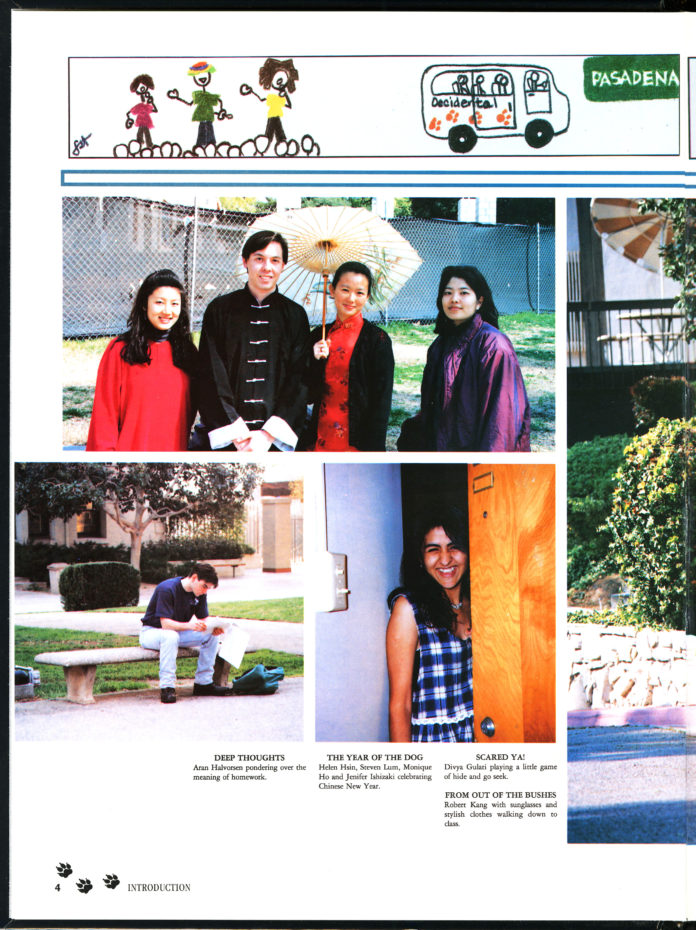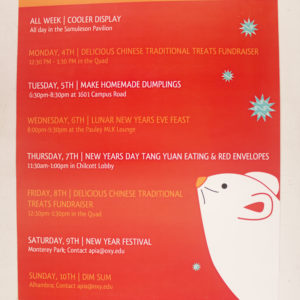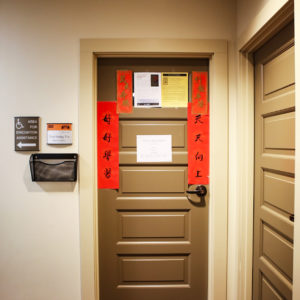
The buildup of festivity begins weeks before the official holidays start. Every January to February, hundreds of millions of people travel back to their hometowns in China. Shops close and businesses halt, but the train stations are swarmed with faces and suitcases and bags of all sizes. This year, the coronavirus outbreak in China that began in December 2019 and resulted in the lockdown of the epidemic center and transportation hub Wuhan has disrupted millions of travelers’ plans. Nonetheless, the largest annual human migration on the planet — the travel season during the Chinese New Year or, as it is known locally, the Spring Festival — consistently marks the joyous hustle and bustle that surrounds the transition between two years.
But Lunar New Year does not equal Chinese New Year. The myriad cultural practices in celebration of Lunar New Year are dazzling, differing between cultures, regions and individual families. It is the time of year when family members come back home, showcasing their respective skills and collective traits through food dishes, holiday greetings, home decor and cultural practices. It is like Thanksgiving in America minus the turkey, Christmas in Europe with lucky money and everything in between.
“It would always be my favorite holiday growing up, because that was one of the only holidays that my mom would take off work and come home,” Sandy Nguyen (junior) said.
Nguyen is a first generation Vietnamese-American who grew up in uptown Chicago. Living in the part of the city that has one of the largest Vietnamese populations, Nguyen has been celebrating Tết — the local name of Vietnamese New Year — ever since. On the eve of the Lunar New Year, her family would go to the Furama Restaurant, an Asian restaurant where many Vietnamese would go to celebrate the New Year together, eating, cheering, playing gambling games and watching — or greeting — lion dances.
“Sometimes your parents would give you a red packet so you would give it to the lion for good luck,” Nguyen said.
The Lunar New Year is the beginning of a new calendar year on either a purely lunar or lunisolar calendar in many Asian countries. While a lunar calendar measures time through the moon’s monthly phases, a lunisolar calendar uses both the sun and the moon. Although it is often associated with the Chinese New Year, the Lunar New Year actually encompasses a wider range of cultural practices and a broader meaning. While countries such as China and Korea share a traditional lunisolar calendar based on the Chinese lunar calendar, other countries such as Thailand and Cambodia use a slightly different type of lunisolar calendar, varying in their intricate terms of calculations. Some countries use a purely lunar Islamic calendar, which gives an even later Lunar New Year date. In the context of the Chinese lunar calendar, Lunar New Year begins on the second new moon after the winter solstice, falling between Jan. 21 and Feb. 21 on the standard Gregorian calendar.

Although the official holidays for Tết in Vietnam and the Spring Festival in China last for seven days, and often stretch to around two weeks in popular practices, Lunar New Year was only celebrated as a one-day holiday in uptown Chicago where Nguyen lives. Within her family, however, the celebration has always started earlier.
“My family, in our living room, has the altar to our ancestors,” Nguyen said. “We have a large one for my grandparents, my grandma and my grandpa, and my mom would always go out and buy the most elaborate bouquets to decorate the altar for the week leading up to it.”
Lilies and chrysanthemums are Nguyen’s mom’s favorites. When Nguyen went back to Vietnam to visit family in Ho Chi Minh City on the Lunar New Year when she was nine, she was amazed by the scale of the festival’s celebration.
“They really, really go all out,” Nguyen said. “They had a festival of flowers in the city down the street. The entire street had different exhibitions of beautiful flowers, and people would be using flowers to make images, portraits, that kind of thing.”
Decorations are just as important to Vietnam’s northern neighbor China, especially when they are red. According to Chinese legend, the celebration of the Spring Festival with many of today’s traditions started with the fight against the mythical beast Nian. Every year Nian allegedly came down from the mountains on the first day of the new year to steal crops, eat people — particularly children — and harass the village. Yet there are three things Nian was afraid of: fire, loud noises and the color red, corresponding to fireworks, drumming and red decorations and clothing.
“There’s a lot of decorations around,” Jason Mittler (senior) said of his hometown Hong Kong.
Because of his grandma’s obsession over a specific type of cha guo — a Hakka dish made with rice flour stuffed with fillings — Mittler often had to cross the city just to buy the one dish. On the streets, New Year markets popped up, suffusing the air with the scent of flowers and attracting children with all kinds of New Year snacks and gadgets.
“It’s a lot of people,” Mittler said. “People are generally — I was actually — happier, in the sense that they’re more cheerful and you’re saying hi to everyone.”
As the only branch of the family that does not permanently live in Hong Kong despite it being his birthplace, Mittler recalled the fireworks from his childhood back in Wuhan, where he grew up and went to school.
“One thing that’s funny is when we were in Wuhan, and new people — like people that weren’t from China — would come to China for the first time. They’re always super scared [on] the night of [the New Year] because the fireworks are so crazy. It was just a whole other level,” Mittler said.
On the first day of the New Year in Taiwan, Stephnie Lin (junior) and her family go to the temple to pray for blessings. A Buddhist family tradition, prayer means entering into the new year with good luck and safety.
“I will say my family’s one of the fewer and more traditional types, and I definitely also grew up with the same value,” Lin said.

But there are others who prefer not to go anywhere at all. According to Xiao-huang Yin, an American/Asian Studies professor at Occidental, what you do on the first day of the year determines what the rest of your year looks like.
“I try to rest as much as I could on the New Year day, if possible,” Yin said. “The first day is very important … If you are going to do something and make yourself busy on this day, you are going to be busy all year.”
Yin came to the U.S. in 1985, leaving his hometown of Nanjing, China, to obtain his M.A. and Ph.D from Harvard University. It was his first time spending the holiday away from home, and there were only around a dozen Chinese students at Harvard back then, according to Yin.
“[I was] lonely,” Yin said. “Because in China you are together with your families this time. If ‘four generations under the same roof’ is not guaranteed, at least you are with your parents, your siblings, your family. But I was alone with my fellow Chinese students.”
Tzu Kit Chan (first year) felt the same pain as he left Kuala Lumpur for college this semester, separated from his family for the first time on Chinese New Year. Despite having the choice to book a flight back a week later, after the New Year, Chan said he eventually decided to not miss school and settle in early.
“It feels awful,” Chan said. “I guess I have my expectation with just some gestures of Chinese New Year. That will have suffice for me. But yesterday I was in a very dark space, dark time, and I didn’t hear much, I didn’t see anything going on, and that broke my heart.”
These estranged feelings gave rise to Lunar New Year-related events hosted by some Occidental cultural clubs.
Laurent Yang (junior), president of Chinese Student and Scholar Association (CSSA), said the annual Chinese New Year Gala hosted by CSSA seeks to recreate the festival’s sense of togetherness and celebration.
“Most of the time people just go out to eat with a few of their friends, which I personally think does not give the crowded and pleasant atmosphere the festival usually has,” Yang said. “Since we are all studying abroad, it is most important to have everyone feel the festive vibe of the Chinese New Year.”
The Chinese Students Association (CSA), the Japanese Cultural Organization (JCO) and the Korean American Students Association (KASA) cohosted a Lunar New Year potluck this year for the first time, according to Lin, the vice president of CSA.
Mei Iwamoto (senior) is the president of JCO. Although Japan stopped celebrating the Lunar New Year in the late 19th century, Iwamoto said JCO still decided to join in cohosting the event as a way to connect with traditional values by interacting with clubs with similar cultural roots. Iwamoto said a lot of the ways people in Japan celebrate the standard new year resemble Chinese traditions during the Lunar New Year, such as eating long noodles, which symbolize longevity.
“We decided to do this event because we thought it would be a good cultural exchange with the rest of the clubs on campus,” Iwamoto said.
Yin said the way the Chinese New Year is celebrated has changed over the decades. However, one tradition Yin has proudly kept was “shou sui,” or observing the New Year’s Day. It is the practice of staying awake until the clock passes midnight and the new year begins. According to Yin, shou sui has a long history rooted in Chinese culture and mythology. The physical act of entering the year by sitting awake symbolizes bringing experiences and memories of the past into the future for continual progress.
Celebrating the Lunar New Year is also a unifying ritual of the Asian community living in another country.
“It’s no longer a culture event but cross-cultural,” Yin said. “No matter what you believe in — whether you are Taiwanese, Chinese, Hongkonger — the occasion crosses ideology and generations regardless of your education background. It is important because it is a symbol of whether or not you identify as an East Asian.”
What does not change about the Lunar New Year holiday is the value of family. Whether it is the scattered candied fruits on the altar or large bowl of poon choi on the big family table, red cotton-padded jackets on northern streets or silky and pristine-white ao dai inside boutiques, the busy trains on the Lunar New Year will continue.
As the nine-year-old Nguyen watched her family in Vietnam place potted trees with budding flowers into the house’s living room fully decorated, reuniting together for a restful week after a year’s hard work, she began to understand the importance of the occasion to herself and her family.
“It is a celebration in time for family,” Nguyen said.
![]()


































